November 9 (Fri), 2007
From Narita/ Kanku (Kansai Airport or KIX) to Kuala Lumpur International Airport (KLIA). Flying to Penang by changing to a domestic airline, arrived by a bus at Bayview Georgetown Hotel.
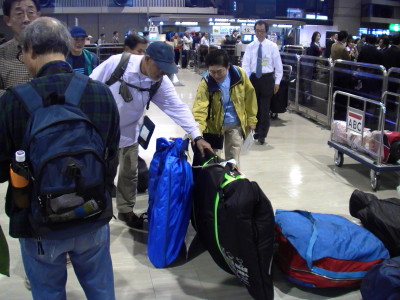
When to check in at the departure airport, large bicycle bags are taken as forwarded baggage (stored in the stomach of the airplane, rather than in passenger seats). Fragile seals are put on the bags.

As soon as arriving at Bayview Georgetown, went out to newly opened collective stalls nearby for late dinner, without waiting for 2 guys flying from KIX. The system is that you occupy any table(s) and order whatever you like from any surrounding stalls, convenient local style. Diverse foods being delicious and reasonable, Malaysian beer is as expensive as in Japan, probably because it is an anti-Islamic and hence evil drinking.
November 10 (Sat)
Opening ceremony in a hotel conference room. Assembling bicycles in front of the hotel, visited Chung Ling High School and laid a wreath for the cenotaph that memorize 54 teachers and students massacred, to which the headmaster attended.
After lunch, went to Butterworth by a ferry boat, and laid another wreath there. Local people welcomed us. On the way back to Georgetown, everybody rode the bus and crossed a long Penang Bridge and stayed in the same hotel.

Assembling bicycles in front of the hotel, while KAITO Tomoi (right) and INADA Jun’ichi (left) watch that. The accompanying bus is ready for the coming 10 day trip with a banner on its side. It traveled from distant KL on previous day with C.C. Yong, our official tour guide/interpreter, and with an accompanying truck. It also made 2 round trips previous night between the airport and Georgetown for members from Narita and KIX.

Bicycle group 1 members are raring to cycle toward Chung Ling High School, with the top being TAKI Hideki. The city route to the school is lined with tall trees, left behind by suzerain UK. Many roads are one way, with plenty of traffic. You are encouraged to cycle as a tight band with narrow gaps each other for safe riding under these circumstances.

Imperial Japanese Army massacred 8 teachers and 46 students of the distinguished Chung Ling High School in the wartime, with allegation of doing anti-Japanese education. Their names are carved on the cenotaph erected in the entrance hall. Mr. Tham Kong Chee, the headmaster, explained the history of the school. The picture is taken after laying a wreath, with the headmaster (central right gentleman with a tie).

The Butterworth Chinese Cenotaph is located within a few pedaling distance from the ferry port (The ferry being free from Penang to Butterworth, you are charged for the return trip). Laid a wreath for the cenotaph where we have visited several times in the past. “MPPC” has been handed over to new generations, though our acquaintances including a survivor of IJA’s atrocity had passed. A banner on their office had a bicycle mark on it, which was seemingly a copy of our past badge.
November 11 (Sun)
From the hotel to the Penang Cenotaph for Chinese Victims after some pedaling. Attended the ritual that started at 11 minutes past 11am. At our turn, MPPC members made a line on the stage and laid a wreath.
After lunch, cycled as far as to Sungai Petani from Georgetown via Butterworth, and visited Beng Siew Sean Siah, the Chinese club in SP. Stayed in Seri Malaysia Hotel.

At 11 minutes past 11am on November 11 every year, a memorial service is held in front of the Penang Cenotaph. We arranged the itinerary of 7MPPC around this ceremony. The cenotaph is close to Chung Ling High School and right before a station for the Penang Cable Car. The date may not necessarily have anything to do with IJA’s particular operation. It might be taken after the settlement of WWI. Chinese people are said to prefer the same figures like this, or good order ones like 1-2-3.
The cenotaph is to memorize Chinese people killed by IJA including teachers and students of Chung Ling, as well as truck drivers and engineers who lost their lives in course of supporting Chiang Kai-shek regime. Photo shows gathering people to the cenotaph.
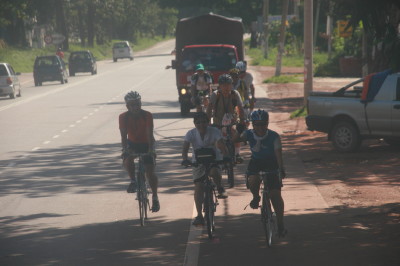
Pedaling toward Sungai Petani on Route #1, after the ritual in Penang and lunch with an old acquaintance, and riding a free ferry to Butterworth. As SP is on a small hill, the road gently rises in the last part. The photo taken from the bus is blurring a bit.

Arriving at Beng Siew Sean Siah, SP, after turning right the Route #1 before the clock tower, and soon after crossing the Malay single rail that runs north-south through the peninsula. The unique name is assumedly equivalent to Chinese Assembly Hall in other locality. It is a social and mutual support club for Chinese people, who think themselves disadvantageous due to being a minority in Malaysian society under the Bumiputera policy that safeguards special positions of the Malays.
Beng Siew Sean Siah was the one to deal with us this time.

In front of the Buddhist memorial tablet building. Among many tablets was a one that reads “114 Chinese men and women who were victimized.” The tablets were enshrined in order of offering amounts.
November 12 (Mon)
Laid a wreath for a cenotaph in the suburb of SP in the morning. Officials of Beng Siew Sean Siah placed votive offerings, which everybody ate soon afterwards on the spot.
Moved to Taiping by the bus. On the way, dropped in a cenotaph that memorizes “3 tribes,” or Chinese, Tamil and Malay. In Taiping, laid wreathes at Commonwealth War Graves and Chinese cenotaph. Took dinner with local dignitaries. Stayed in Legend Inn, Taiping.

In the morning, pedaled to a Chinese cenotaph in the suburb of SP, where 2MPPC had visited in 1996. Officials of Beng Siew Sean Siah placed votive offerings of cakes and fruits. Dato Koh Keng Wing, vice president (central right), wears a thin yellow gown in a solemn manner. After laying a wreath, everybody shared the offering of apples, meat buns and spirits, etc., a spontaneous and invaluable reconciliatory joint ceremony by Chinese victims and their descendants with invader’s posterity.

On the way to Taiping, stopped the bus on the North-South Highway, stepped over a fence, and laid a wreath for a “3 tribes” cenotaph in a grassy hill. This is for Chinese, Tamil and Malays, meaning that majority of anti-Japanese resistant movements being shouldered by Chinese, there were 2 other “tribes” as well.
Guided by the tour guide CC Yong, who said that detailed incident in Pandar Bahru, Kedah are unknown.

Commonwealth War Graves are in the mountain side of a big Lake Garden, Taiping. Across a lane there are one for Christians and the other for non-Christians. Commonwealth soldiers who perished in defense operation of Malaya in 1941/42 are mainly buried here. The photo is in Christian graves. MPPC laid wreathes to the both graves, where Mr. Beh Yang Toh, Perak President of Chinese Cultural Association, and others welcomed us.

Commonwealth War graves are neatly maintained by its committee, just as in Kanchanaburi, Thailand, Kranji, Singapore and Hodogaya, Yokohama.

A large Perak public cenotaph for Chinese victims of anti-Japanese is located in a periphery of the Lake Garden, where we have visited several times. However, we have never learned details of those victims yet. Assumedly it is for all the victims of Perak.
Collective photo with Mr. Beh and other members of Taiping Peace Committee. On our way to Legend Inn, cycled along the circuit road of the Garden; the lake is where tin was mined in the past.

Pork-free Chinese dishes were served on dinner at a Club House in the Lake Garden. The British made golf club was succeeded by local people as a center for various sports including tennis, swimming, squash, etc.
Seated together are, from right, Mr. Beh Yang Toh, Dr. Jannie, an advocate of health with special breathing, and Dato Seri Wan Ahmad, the Representative of Perak Sultan in Taiping. His grandfather’s grandfather was a heroic worrier who slashed a British soldier. There were some other distinguished guests of Taiping present.
November 13 (Tue)
Went to Salak Utara from Taiping by bicycles and the bus. Paid respect to the cenotaph for the first time as Japanese. Could learn a detailed story of the massacre there. Proceeded to Ipoh by bus, and stayed in Syuen Hotel.

Saying good bye to Mr. Beh and others at the Lake Garden, headed toward Kuala Kansar on the highway by the bus. The biggest Perak River flows in the town, along which stands a gorgeous palace of the Perak Sultan. After early lunch, forwarded to Salak Utara by bicycles. The Route #1 was a moderate uphill road, since steep part had ended between Taiping and Kuala Kansar; pleasantly sweated.

Salak Utara is a small village on hills. Here in 1942, IJA ordered hundreds of the village men to gather at a basket court, picked up 14 teachers and villagers after identification, confined them in a school class room for 3 days, and finally killed them near a railway station. There is a tomb in a coconut hill outside of the village, on which their names are carved. MPPC was said to be the first Japanese to visit the site. When we walked to the tomb, many villagers accompanied us as though all the village population joined.

After MPPC laid a wreath, everybody including the villagers offered incense sticks. As all the victims names are carved, it is apparent that everybody clearly remember the tragedy of 60 years before. In other words, for people of Salak Utara, the IJA committed atrocity is still not solved at all.
November 14 (Wed)
Visited historical sites in Ipoh City with a guidance of Mr. Law Siak Hong and others, Perak Heritage Society. In a suburban Batu Gajah, a jail in the wartime is still functioning. At another suburban Papan met Ms. Olga Kathigasu. In the night, Perak Veteran Friendship Association invited us for homemade dinner and a discussion session. Stayed in Syuen.
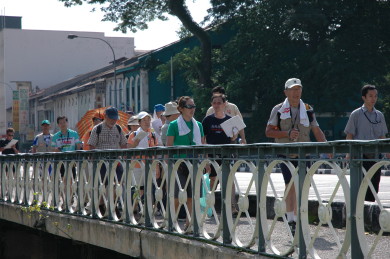
A bridge on Kinta Valley, Ipoh. The town was once flourish as plenty of tin was mined in the river. Visited on foot several historical spots related to IJA occupation including Kempeitai (military police) station, row houses used for bordello, a covered shop of anti-Japanese resistant movement where prominent Singaporean leader of Force 136 Mr. Lim Bo Seng dropped in, etc.

Batu Gajah has been an administrative town having a court and a jail since when Ipoh enjoyed immense prosperity. IJA detained Mr. Lim Bo Seng in the jail, where he died, and tortured Ms. Sybil Kathigasu gruesomely in allegation of medi-caring anti-Japanese soldiers. As she could not walk due to the torture when released after the war, she crawled to the nearby church, Saint Joseph, and prayed God thanking for survival.
Unfortunately Sybil could not recover the health, and passed away in 1949 at a hospital in Scotland. It is recorded that local residents made a long line to see her off at Ipoh.

Having had a clinic in Ipoh before the war broke out, Dr. and Sybil Kathigasu made another one in suburban Papan after Japanese occupation, and Sybil mainly worked here. Anti-Japanese soldiers secretly visited the clinic for medicines, to whom Sybil gave with no charge. As IJA suspected the fact, arrested her, tortured acutely to know whereabouts of the guerillas, but to no avail.
IJA then arrested her younger daughter Dawn, and threatened Sybil by trying to burn Dawn in a fire. Luckily however, without success Dawn was released and sent home. The elder sister Olga Kathigasu witnessed the first hand story in details.
From left; SAKAMOTO Atsuko, YUNOKI Yasuko, YAMAGUCHI Hiroko, Olga Kathigasu, SATO Kaori, and HOSHI Yumiko.

Mr. Law Siak Hong scantily manages the former clinic in Papan as a museum of Sybil Kathigasu. Mr. Law (center) is the president of Perak Heritage Society. The right hand is ONOGI Yoshiyuki.

Dinner and discussion session sponsored by Perak Veteran Friendship Association. The community center was in the northern part of Ipoh, opposite to the daytime places. Enjoyed homemade dishes.

Coincidently, we had met Mr. Hew Yoon Tat, the president of PVFA, in 3MPPC at another suburban Bukit Merah. He was supporting juveniles suffering from aftereffects of radio actives that a JV with Mitsubishi Chemicals carelessly dumped. The backdrop of the meeting room was partially written in Japanese.
PVFA is a relatively new organization with mission of praising those people who engaged in anti-Japanese resistant activities and hand down the stories from generation to generation. A former high school teacher Mr. Low Toh Nam has been earnestly collecting relevant data for the PVFA. He had explained to us at Salak Utara previous day.
November 15 (Thu)
Went to southward by the bus from Ipoh in the morning, and laid wreathes for Chinese cenotaphs in Bidoh, Coldstream, Sungkai, etc. Mr. Low guided us. Wherever we went, around 10 local people waited us. Having had no information about these places before, we went through the area by train in 3MPPC.
After dark, we said good bye to Mr. Loh and the headman of Sungkai Village, etc., headed to KL and stayed in Federal KL, Bukit Bintang.

At 8am, started toward the south by the bus on the highway, guided by Mr. Low Toh Nam. Getting off at Tapah IC, headed to mountains. Though rode bicycles for a while at our earnest request, we soon gave up. The road condition was far from comfortable cycling.
About 10 local folks waited for us on the way with pickups and motorbikes, obviously coordinated by Mr. Toh, for which we admired and thanked.
Alighting from the bus, everybody was transferred by the pickups and motorbikes.

As the road became narrower, we finally left the pickups and motorbikes, and walked further for about 40 minutes, before arriving at the “isolated tomb.” (TAMIYA Hiroshi in right)
Manman, Bidoh was the name of the jungle. It is said that IJA smelled out a hut near a tin ore washing factory which was used by anti-Japanese guerillas, confined them in the hut, and burnt them to death.

Despite being located in a deep jungle, flowers of seemingly several days old were offered to the “isolated tomb.” On the gravestone, 18 persons’ names were carved. There were some more unidentified persons also killed by IJA.
According to “Another Malaysia & Singapore” written by Mr. Lu Pei Chun, who we would meet the next day in KL, Force 136 and communist guerilla force had meetings in Bidoh in the wartime. IJA’s reconnaissance must have been effective enough to rightly trace the site like in Bidoh, but cannot be justified to massacre local people who fought against the invaders.

On the way back, dropped in another similar tomb and laid a wreath. About 100 people were brought here and killed, but further details are unknown, according to a witness of a local man. At least the Chinese characters carved on the stone are clear, which read “Tomb of Anti-Japanese Heroes.”

Returning to Route #1, took lunch in the town of Bidoh, and then headed westward or toward Malacca Strait. Dropped in a small cenotaph in a grassy road side about 9km away, which we rode bicycles enjoying scarce traffic. Two names were carved on it. The two guerillas lost their lives in late August 1945 at a gunfight with IJA, which was in charge of maintaining security entrusted by UK even after its surrender.
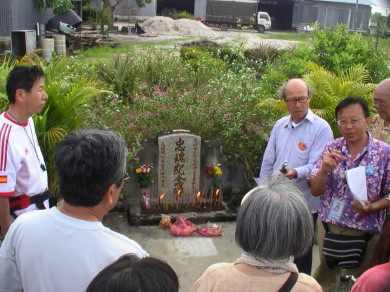
Photo taken in Coldstream New Village, further west. According to a witness by Mr. Chai Kon who used to live here in childhood, 12 men and women were brought from somewhere in January 1944, put in a nipa house, and burnt down.

Mr. Loh explains at Coldstream, recent retiree of a high school teacher. OSHIMA Shin’ichi in the right.
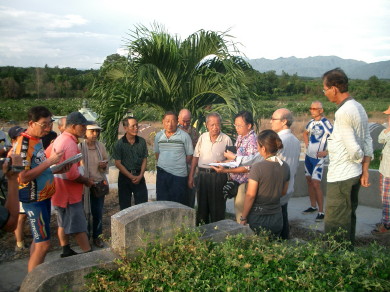
Running further south by the bus, arrived at Sungkai Chinese Cemetery. There was a relatively new tomb that commemorates 3 Chinese who were shot dead by Malay and Indian policemen after they tried to acquire guns from a police station for anti-Japanese purpose. Mr. Ku Yook Nan, the village headman and retired Malaysian army major, explained to us. The tomb was once in the city center, but moved recently with funds raised by Chinese volunteers. There were documents recording how the 3 guerillas tried to flee via which lanes in the town.
The explanation was a good example of how anti-Japanese heroes are respected and the stories handed down among Chinese society today. The headman invited us to a town shop and treated us with yum cha or dim sum.
November 16 (Fri)
Proceeded from the hotel to a huge Chinese cemetery in KL by the bus. Laid wreathes to 3 cenotaphs which we have been familiar with. Moved to the magnificent building of KL-Selangor Chinese Assembly Hall nearby. Welcome lunch by the 8.15 Committee officials who have been meeting us since 4MPPC. Some members from the both parties made table speeches.
Wrap up meeting in the afternoon, one day before the last day, and stayed in Federal KL again.

There is a big forest cemetery on a hill in the central part of KL, Kwong Tong Cemetery, where we moved by the bus. Laid wreathes to 3 cenotaphs, for truck drivers and engineers who volunteered to transport supply materials to Chiang Kai-shek regime in Chongqing, for over 1000 Chinese men and women killed in Pudu Prison and others, and for those killed in Pudu and their corpses dumped rudely at the site. (Photo shows YUNOKI Yasuko laying a wreath to the one for over 1000)
Every year on August 15, a memorial ceremony is held in front of the second one, under auspices of the 8.15 Committee.

Moved for a few minutes by the bus from the Kwong Tong Cemetery to KL-Selangor Chinese Assembly Hall building located in front of Maharajalela Station, monorail. Mr. Ong Seng Khek, the president of the 8.15 Committee (one organisation under the Chinese Assembly Hall) and other acquaintances welcomed and invited us to lunch in the restaurant in the building. After exchanging greetings from the both sides, had a spontaneous table speech session.
Photo is taken at the facade of the Hall; Mr. Ong Seng Khek is in the center front, and Mr. Lu Pei Chun in the extreme right of the rear row.
November 17 (Sat)
Free time in the morning. Most of the members toured by the bus to Petronas Twin Tower, Istana Negara (palace), National Mosque, etc. In the afternoon on the way to the airport (KLIA), dropped in Nilai Memorial Park, where was a brand new 9.1 Heroes Memorial. Departed KLIA, separating into Narita and KIX groups, returned home safely.

Visited several tourist spots in KL in the free morning. Women should not expose their hair when to enter the National Mosque; skirts are not allowed neither. Islamic rules in Malaysia are generally stricter than in neighboring countries.
From left; YUNOKI Yasuko, SAKAMOTO Atsuko, HOSHI Yumiko, SATO Kaori, and YAMAGUCHI Hiroko.

On the way to the airport (KLIA), dropped in Nilai Memorial Park which is only accessible from the toll highway. Laid wreathes for “9.1 Heroes Monument” and “Anti-Japanese Heroes Monument in Malaysia” which were just completed in early 2007. The 9.1 heroes are the ones who were either shot dead or arrested by IJA on September 1, 1942, when they gathered in Batu Cave, northern part of KL. They were to discuss ways to rebuild Malayan Communist Party, which had been seriously damaged by IJA’s mopping-up operation in February/March the same year.

Fact of erecting such cenotaphs quite recently in a country like Malaysia where anti-communism is the national credo, shows how earnestly present Chinese people appreciate and respect anti-Japanese activities of the forerunners.

Saying thank you for 10 days services and good bye to CC Yong (extreme left), tour guide and interpreter, Hassan (second from left), truck driver, and Sunny (third), bus driver, at KLIA. Extreme right is NISHIMURA Hiroshi. Both groups of Narita and KIX returned home with respective night flights.